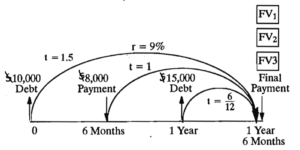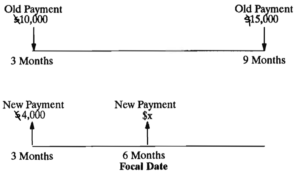3.9 Equations of Value
Key Takeaways
In many business situations, debts are not paid exactly as specified in contracts. Often a payment is made to partially offset a debt.
When two companies regularly carry out transactions with each other, there is often a running account arrangement, where debts and payments accrue over a period of time, with a final payment to settle the account.
Focal Dates
When there are multiple inflows and outflows, it is common to evaluate them all at a common date, often the date of the last payment. In this case, the time of the final payment is used as a focal date, and all debts and payments are “moved” to the focal date, and their EQUIVALENT VALUES calculated.
Example 3.9.1
Assume that we have two debts: $10,000 owed today and $15,000 owed one year from today. The company makes a payment of $8,000 six months from today and will make a final payment 1.5 years from today. The interest rate is 9%.

If the company wishes to settle the outstanding debt at the 1 year 6 month point, all the dollar amounts are “moved” to the 1 year 6 month point (the date of the final payment) where they can be added and subtracted. This point is called the FOCAL DATE.

First, calculate all FV. (EQUIVALENT VALUES)
[latex]\begin{align*} FV_1 &=$10,000(1+0.09\times1.5) = $11,350\; (value\; of \;first \;debt)\\ FV_2 &=$8,000 (1+0.09\times1) = $8,720\; (value \;of \;first \;payment)\\ FV_3&=$15,000 (1+0.09\times0.5)=$15,675\\ \end{align*}[/latex]
Next, think about a balancing transaction at the focal date, where:
[latex]\begin{align*} Value\; of\; all\; payments &= Value\; of\; all\; debts\\ $8,720 + LAST PAYMENT &= $11,350 + $15,675\\ LAST PAYMENT &= $27,025 - $8,720 = $18,305\\ \end{align*}[/latex]
Key Takeaways
- The $10,000 debt is a debt of $11,350 on the focal date.
- The $15,000 debt is a debt of $15,675 on the focal date.
- The payment will have accumulated interest CREDIT, so that the $8,000 payment is worth $8,720 on the focal date.
- The total debt value on the focal date $11,350 + $15,675 = $27,025 is offset by the value of the payment, $8,720, so that the balance owing is $27,025 − $8,720 = $18,305. All payments and debts are “moved” to a focal date at the time of the final payment, and a payment−debt balancing EQUATION of VALUE is set up and solved for the unknown value.
The effect of interest is calculated every time a payment is made.
Solving Equations of Value
Key Takeaways
The technique of “moving” all dollar amounts to a FOCAL DATE and setting up a balancing equation, can be used in a variety of situations where unknown values must be calculated. There are many occasions when the focal date may be established at ANY TIME by agreement between the creditor and the debtor.
Example 3.9.2
To settle a current debt your company has agreed to make payments of $10,000, 3 months from now and $15,000, 9 months from now. When the first payment becomes due, the company finds itself short of cash and enters into negotiation with the creditor. Eventually the creditor agrees that if the company makes a partial payment of $4,000 at the 3 month point, the balance must be paid at the 6 month point.
This is the situation:

Both debtor and creditor agree that the six month point will be the FOCAL DATE for calculations and that the payments will be valued using 9% simple interest. The two old payments are replaced by two new payments, with the second new payment, unknown, shown as x.
All dollar values are compared at the focal date.
Each dollar value is “moved” to the agreed focal date, and an EQUATION OF VALUE is set up to balance the values of old payments and new payments at the FOCAL DATE.

[latex]\begin{align*} FV_1 &=$10,000 \left(1 + 0.09\times\frac{3}{12}\right)= $10,225.00 (old)\\ FV2 &= $4,000\left(1 + 0.09\times\frac{3}{12}\right) = $4,090.00 (new)\\ PV_3&= \frac{$15,000}{\left(1 + 0.09\times\frac{3}{12}\right)}=$14,669.93 (old) \end{align*}[/latex]
The FOCAL DATE EQUATION is:
[latex]\begin{align*} \text{Value of new payments} &=& \text{Value of old payments} x + $4,090.00 &=&$10,225.00 +$14,669.93\\ x &=&$24,894.93 - $4,090.00\\ x &=&$20,804.93 \end{align*}[/latex]
Now, let us look at a slightly more complicated set of payments. Assume that the agreement is for two payments, one at the 3 month point and one at the 6 month point as before, but with the second payment being exactly $15,000 more than the first payment. Now both new payments are unknown. However, they are related. If x is the first payment, then (x +$15,000) must be the second payment.
[latex]FV_1 =$10,000 [1 + (0.09\times \frac{3}{12})] = $10,225.00\; (old)[/latex]
[latex]FV_2 = x [1 + (0.09\times \frac{3}{12})] = 1.0225x\; (new)[/latex]
[latex]PV_3= \frac{$15,000}{1 + (0.09\times\frac{3}{12}) }=$14,669.93\; (old)[/latex]
The EQUATION OF VALUE at the focal date is:
Value of new payments = Value of old payments
[latex](x+$15,000)+1.0225x=$10,225.00+$14,669.93[/latex]
[latex]x+1.0225x=$10,225.00+$14,669.93-$15,000[/latex]
[latex]2.0225x=$9,494.93[/latex]
[latex]x=\frac{$9,494.93}{2.0225}=$4,892.43[/latex]
The first new payment (x) is $4,892.43 and the second new payment is $4,892.43 + $15,000 or $19,892.43.
Knowledge Check 3.8
Knowledge Check 3.9
Your Own Notes
- Are there any notes you want to take from this section? Is there anything you’d like to copy and paste below?
- These notes are for you only (they will not be stored anywhere)
- Make sure to download them at the end to use as a reference
The date at which we make the calcualtions.... (FIX)

